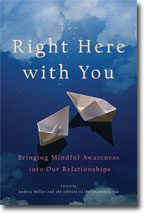 This week, I’m reading Right Here With You: Bringing Mindful Awareness into our Relationships (Shambhala). It’s a wonderful collection of essays from mindfulness and Buddhist teachers, from Thich Nhat Hanh to Tara Brach on the value of relationships for the spiritual path. It’s organized into sections: Visions of Mindful Loving, Preparing the Ground, Being in Relationships, Dealing with Difficulties, Growing Apart, and Love as a Spiritual Path.
This week, I’m reading Right Here With You: Bringing Mindful Awareness into our Relationships (Shambhala). It’s a wonderful collection of essays from mindfulness and Buddhist teachers, from Thich Nhat Hanh to Tara Brach on the value of relationships for the spiritual path. It’s organized into sections: Visions of Mindful Loving, Preparing the Ground, Being in Relationships, Dealing with Difficulties, Growing Apart, and Love as a Spiritual Path.
The image of the lone seeker in the Himalayan cave is quaint. Contemporary sadhana (spritiual practice) takes place in the real world, and this real world is comprised of relationships with our spouses and children, parents and siblings, bosses and co-workers, friends and animals. Of course, we are also in relationship with ourselves. These relationships are not obstacles to the spiritual path — they are the path. This proposition is explored in many of the essays. In some ways, being a celibate monk is easier than being in a marriage. In marriage, you can’t hide behind the monastic code, you are right there on the front lines of life with each other or against each other — mindfulness may determine the one or the other.
If we can be mindful in our most important relationships we can be mindful anywhere. In the process of attaching to another human being, all of our attachments will be revealed. This double meaning of attachment is the central feature of our humanity. On the one hand, we are biological beings who must “attach” to caretakers to survive. The ability to attach and the desire for caregivers to give attuned care is built into the core of who we are. On the other hand, as human beings we can transcend our biological programming and seek to be in the world in ways that are intentional and not purely driven by instinct. Thus, we seek not to be attached to things, outcomes, and even people as a way to minimize our anguish.
I particularly enjoyed the brief essay by mindfulness teacher, Diana Winston. She makes the case that mindfulness practice is nothing other than the practice of love. It becomes love by training us to say yes to our life. “Because hour after our, you learn to say yes. Yes to your jagged breathing, yes to your itchy scalp. Yes to the leaf-blowr dude across the street, yes to your grief and pain an shame and grandiosity and fear.” If we can say yes to the conditions of our life we can open to the conditions of another.
John Welwood has written about relationships as a spiritual path for years. In his essay, “Intimate Relationships as a Spiritual Crucible,” he says:
When we fall in love, this usually ushers in a special period, one with its own distinctive glow and magic. Glimpsing another persons’a beauty and feeling, our heart opens in ressponse, providing a taste of aboslute love, a pure blend of openness and warmth. This being-to-being connection revales the pure gold at the heart of our nature, qualities like beauty, delight, awe, deep passion and kindess, generosity, tenderness, and joy.
Yet opening to another also flushed to the surface all minds of condionted patterns and obstalces that tend to shut this connection down: our deepest wounds, our grapsing and desperation, our worst fears, our mistrust, our rawest emotional triggers points. As a realationship develops, we often find that we don’t have full access to the gold of our nature, for it remains embedded in the ore of our conditioned patterns. And so we continually fall from grace.
How can we resolve this conundrum? Read this and the other essays in Right Here With You to find out.

